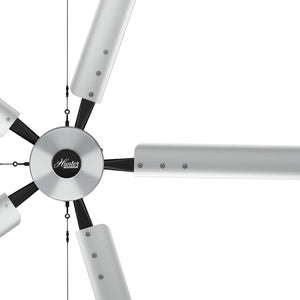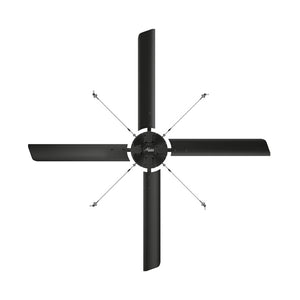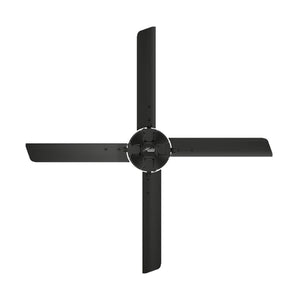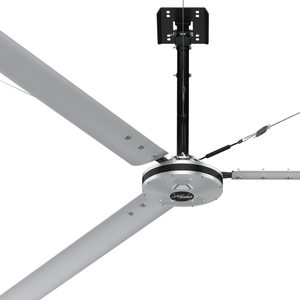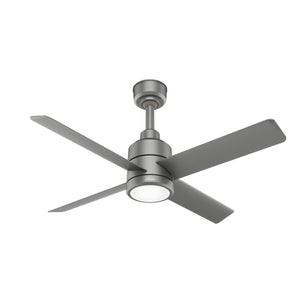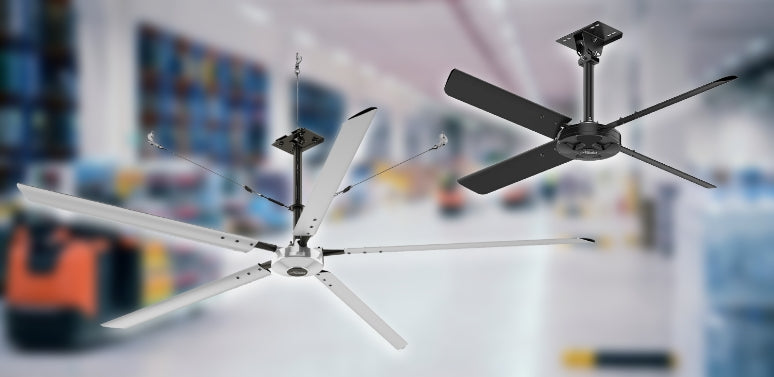Strategic Placement of HVLS Fans for Optimal Effectiveness

When you want to circulate air efficiently in big spaces, your go-to choice has to be High-Volume, Low-Speed (HVLS) ceiling fans. These gentle giants have become indispensable tools in industrial and commercial buildings thanks to their ability to move large volumes of air with minimal energy. While their stellar abilities are never in doubt, one consideration that's sometimes overlooked is the strategic placement of HVLS Fans for optimal effectiveness.
When installed properly, HVLS fans can create a cooling effect, lower energy costs, and improve air quality. However, poor placement diminishes their effectiveness, leading to underperforming air circulation, energy inefficiencies, or equipment wear over time.
So, what are the best practices for industrial HVLS fan setup? We have the answers for you. We'll start with the basics on HVLS fans, talk about how to account for room size, ceiling height, existing ventilation systems, and obstacles that could interfere with airflow. By the time we're through, you'll have a solid understanding of how to strategically install HVLS fans to get the most out of your investment.
Understanding HVLS Fans

High-Volume, Low-Speed (HVLS) fans are specialized ceiling fans engineered to move large volumes of air at low rotational speeds. Their primary purpose is to create a steady, gentle airflow that helps regulate temperatures in big spaces, such as warehouses, recreation centers/gyms, or manufacturing facilities. Unlike traditional fans that operate at high speeds to cool smaller areas, HVLS fans operate more slowly but can push a high volume of air across much larger spaces.
HVLS Fans vs. Traditional High-Speed Fans
The main difference between HVLS and traditional high-speed fans is their airflow strategy and energy use. While high-speed fans create fast, concentrated airflow for smaller areas, HVLS fans take a more holistic approach, moving air slowly but covering more ground. This helps reduce temperature stratification (where warmer air rises and cooler air settles), making HVLS fans a great choice for maintaining consistent temperatures in large spaces.
HVLS fans are also more energy-efficient since fewer fans are needed to achieve the same effect. A traditional high-speed fan might need to run continuously at high power to cool a specific area. In contrast, one well-placed HVLS fan provides effective air circulation with far lower energy use.
HVLS Fan Characteristics
HVLS fans generate a large column of air that moves downward and flows out in all directions, creating a steady breeze throughout the space. Here are other distinguishing characteristics:
- Size and Coverage: HVLS fans have blades up to 24 feet in diameter, capable of circulating air across areas as large as 22,000 square feet with just one fan.
- Energy Efficiency: With fewer revolutions per minute (RPM), HVLS fans consume less energy than multiple smaller, high-speed fans. Learn more about energy efficiency and HVLS fans
- Quiet Operation: Thanks to dependable direct-drive motors – like those found in Hunter HVLS fans – you'll experience minimal noise, enhancing comfort in sound-sensitive environments.
HVLS Fan Benefits
HVLS fans help create more comfortable environments while also cutting energy costs. Here's a quick breakdown of their advantages:

- Improved Airflow and Air Circulation: HVLS fans create consistent airflow across large spaces, preventing stagnant air pockets and promoting better air quality throughout the area.
- Temperature Control and Increased Comfort: By mixing the air more evenly, HVLS fans help reduce temperature differences between floor and ceiling, creating a more comfortable environment for employees and customers, regardless of the season.
- Energy Savings and Cost-Effectiveness: HVLS fans lessen the burden on HVAC systems, thereby lowering overall energy consumption and cooling costs.
- HVLS Controls: Many HVLS fans have advanced control systems, allowing users to adjust speed, integrate with building management systems, and automate operations to further improve efficiency and convenience.
EXPLORE OTHER CATEGORIES
Strategic HVLS Fan Placement
When installing HVLS fans, it's important to consider these factors for the best performance and efficiency:
- Identify Problem Areas: Locate heat-prone or stagnant air zones (e.g. center of room, near machinery, high-traffic spots).
- Ceiling Height: Large fans 20 to 24 feet in diameter perform best at 20 to 30 feet above the floor, but acceptable performance has been demonstrated as low as 10 feet and as high as 50 feet.
- Room Dimensions and Shape: The room's dimensions influence airflow patterns, so larger or irregular spaces may require multiple fans for proper coverage.
- Avoid Obstructions and Barriers: Beams, shelving, lights, or machinery can block airflow, so positioning fans to avoid obstructions is essential for efficiency.
- Assess Coverage Needs: Match the fan size to your space's area. Most large HVLS fans cover around 10,000–20,000 square feet.
- Space Multiple Fans Evenly: Proper placement depends on the diameter of the blades. For example, 24-foot fans should be positioned a minimum of 60 feet apart to avoid airflow overlap and a maximum of 120 feet to ensure adequate coverage. Follow the manufacturer's instructions for best results.
- Type of Fan: Different HVLS fans are suited for specific environments. Choosing the right one ensures optimal airflow and energy efficiency. To learn more about selecting the right fan for your space, check out Hunter's Fan Size Guide.
- Number of Fans Required: Large, open spaces often need multiple HVLS fans to achieve consistent air circulation. The Hunter Industrial & Commercial catalog lists each fan's maximum affected area.
- Prioritize Comfort Zones: Place fans near work areas or where circulation is essential.
- Set Seasonal Directions: In summer, push air down for cooling; in winter, reverse direction to circulate warm air.
Pro Tip: Using Hunter's convenient HVLS Selection Tool makes it easy to determine the type and number of fans your facility will need, based on the square footage of your space and the height of your ceiling.
Optimal HVLS Fan Positioning in Different Settings
The strategic placement of HVLS fans varies depending on the environment. Each setting has unique challenges that require specific positioning strategies to achieve optimal airflow and comfort.
- Industrial Warehouses: In warehouses with high ceilings and wide-open spaces, fans should be positioned to prevent air from stratifying. Placing fans in the center of work zones or between storage aisles ensures consistent airflow throughout the facility.
- Commercial Spaces: In retail and office settings, fans enhance customer and employee comfort by improving circulation. Positioning them where people gather, such as lobbies or waiting areas, maximizes comfort without excessive energy use.
- Agricultural Environments: Barns, greenhouses, and storage facilities need proper air circulation to control humidity and temperature. Placing HVLS fans near entry points or in areas with limited natural airflow helps maintain optimal conditions for livestock, plants, or produce.
Locations to Avoid When Placing HVLS Fans
When creating a layout for HVLS fan placement, keep in mind you'll need to mount fans away from the following:
- Sprinkler Systems
- Walkways and Mezzanines
- Lights and Skylights
- Air Discharge Locations
- Windy Locations
- Wet Locations
Detailed instructions can be found in the Hunter HVLS Installation Manual.
Hunter Industrial's Partnership With Mitsubishi Electric
Get an inside look at how Hunter collaborates with clients, from planning to installation of world-class industrial fans.
FAQs: Strategic Placement of HVLS Fans for Optimal Effectiveness
Yes, HVLS fans work alongside HVAC systems to improve energy efficiency. During the summer, HVLS fans enhance cooling by evenly distributing conditioned air, reducing the workload on the HVAC system. In the winter, they help with destratification, pushing warm air down from the ceiling to reduce heating costs. However, fans should not be located directly beneath any vertical air discharge. This includes air conditioning units and evaporative coolers. Such equipment can be used effectively in conjunction with HVLS fans; however, the discharge of the unit must be located outside the swept area and at a distance of at least two times the diameter of the fan. This article on HVLS fans and air conditioning provides an in-depth view of how the two systems work together.
HVLS fans use less power while covering a much larger area compared to traditional high-speed fans. Over time, this leads to impressive energy savings.
HVLS fans are low-maintenance, requiring occasional cleaning of blades and routine inspections to ensure the motor and mounting hardware are in good condition. Depending on the environment, they may need more frequent cleaning in areas with high dust or debris levels.
For your peace of mind, Hunter Industrial Precision Services offers optional Inspection & Maintenance Services.
Also, Hunter-branded HVLS fans – the mighty Titan, economical ECO, and efficient XP – come with a Limited Lifetime Warranty.
Hunter Industrial, Your Best Source for Energy-Efficient HVLS Fans
If you're ready to optimize your facility with the best in HVLS technology, Hunter Industrial & Commercial is ready to help with energy-efficient solutions designed to meet the unique needs of your space. Isn't it time to take the first step toward a more comfortable and cost-effective environment?

 100% Secure Payments
100% Secure Payments